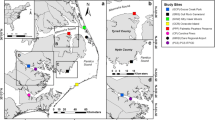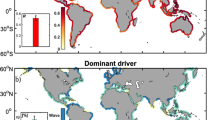Abstract
This paper investigates changes in shoreline evolution caused by changes in wave climate. In particular, a number of nearshore wave climate scenarios corresponding to a ‘present’ (1961–1990) and a future time-slice (2071–2100) are used to drive a beach evolution model to determine monthly and seasonal statistics. To limit the number of variables, an idealised shoreline segment is adopted. The nearshore wave climate scenarios are generated from wind climate scenarios through point wave hindcast and inshore transformation. The original wind forcing comes from regional climate change model experiments of different resolutions and/or driving global climate models, representing different greenhouse-gas emission scenarios. It corresponds to a location offshore the south central coast of England. Hypothesis tests are applied to map the degree of evidence of future change in wave and shoreline statistics relative to the present. Differential statistics resulting from different global climate models and future emission scenarios are also investigated. Further, simple, fast, and straightforward methods that are capable of accommodating a great number of climate change scenarios with limited data reduction requirements are proposed to tackle the problem under consideration. The results of this study show that there are statistically significant changes in nearshore wave climate conditions and beach alignment between current and future climate scenarios. Changes are most notable during late summer for the medium-high future emission scenario and late winter for the medium-low. Despite frequent disagreement between global climate change models on the statistical significance of a change, all experiments agreed in future seasonal trends. Finally, a point of importance for coastal management, material shoreline changes are generally linked to significant changes in future wave direction rather than wave height.
Similar content being viewed by others
References
Abernethy CL, Gilbert G (1975) Refraction of wave spectra. Hydraulics Research Station, Wallingford Report INT117, May 1975
Alexander LV, Tett SFB, Jónsson T (2005) Recent observed changes in severe storms over the United Kingdom and Iceland. Geophys Res Lett 32:L13704. doi:10.1029/2005GL022371
Bidlot JR, Holt MW (1999) Numerical wave modelling at operational weather centres. Coast Eng 37(3–4):409–429
Bidlot JR, Holt MW (2006) Verification of operational global and regional wave forecasting systems against measurements from moored buoys. JCOMM Technical Report, 30. WMO/TDNo.1333
Bradbury AP, Mason TE, Holt MW (2004) Comparison of the performance of the Met Office UK-Waters wave model with a network of shallow water moored buoy data. In: Proceedings of the 8th international workshop on wave hindcasting and forecasting. Hawaii
CERC (1977) Shore protection manual. Coastal Engineering Research Center, U.S. Corps of Engineers, Vicksburg
CERC (1984) Shore protection manual. Coastal Engineering Research Center, U.S. Corps of Engineers, Vicksburg
Christensen JH, Christensen OB (2007) A summary of the PRUDENCE model projections in European climate by the end of this century. Climatic Change 81(Supplement 1):7–30
Christensen JH, Christensen OB, Lopez P, van Meijgaard E, Botzet M (1996) The HIRHAM4 Regional Atmospheric Climate Model. DMI Scientific Report No. 96-4, DMI Copenhagen
Cotton PD, Carter DJT, Allan TD, Challenor PG, Woolf D, Wolf J, Hargreaves JC, Flather RA, Bin L, Holden N, Palmer D (1999) JERICHO—the impact of a changing wave climate on our coasts. Technical Report, BNSC LINK project R3/003, Satellite Observing Systems, UK
Debernard JB, Rǿed LP (2008) Future wind, wave, and storm surge climate in the Northern Seas: a revisit. Tellus 60A:427–438
Dickson M, Walkden M, Hall JW (2007) Systematic impacts of climate change on an eroding coastal region over the twenty-first century. Climatic Change 84(2):141–166
Donelan M (1980) Similarity theory applied to the forecasting of wave heights, periods and directions. In: Canadian coastal conference, Burlington, Canada, pp 47–61
Donelan MA, Hamilton J, Hui WH (1985) Directional spectra of wind-generated waves. Philos Trans R Soc Lond, Ser A 315:509–562
Douglas BC, Kearney MS, Leatherman SP (2001) Sea level rise: history and consequences. Academic Press, San Diego, US, p 232
Feyen L, Dankers R, Barredo JI, Kalas M, Bódis K, Roo A, Lavalle C (2006) Flood risk in Europe in a changing climate. Institute of Environment and Sustainability, PESETA Project, Report EUR 22313 EN, 20 pp
Freund JE (1992) Mathematical statistics. Prentice Hall, Inc, New Jersey, p 576
Golding B (1983) A wave prediction system for real time sea state forecasting. Q J R Meteorol Soc 109:393–416
Gravens MB, Kraus NC, Hanson H (1991) GENESIS: generalized model for simulating shoreline change. Report 2, Workbook and System User’s Manual. U.S. Army Corps of Engineers
Gulev SK, Hasse L (1999) Changes in wind waves in the North Atlantic over the last 30 years. Int J Climatol 19:1091–1117
Günther H, Rosenthal W, Stawarz M, Carretero JC, Gomez M, Lozano L, Serrano O, Reistad M (1998) The wave climate of the Northeast Atlantic over the period 1955–1994: the WASA wave hindcast. Global Atmos Ocean Syst 6:121–163
Halcrow Ltd (2004) Poole Bay and harbour strategy study—assessment of flood and coast defence options—Poole Bay. Halcrow report, 57 pp
Halcrow Maritime (1999) Poole and Christchurch Bays Shoreline Management Plan. Report to Poole Bay and Christchurch Bay Coastal Group (Lead Authority: Bournemouth Borough Council) Volume 2: Physical Environment
Hanson C, Goodess CM (2004) Predicting future changes in wind. Climate Change Research Unit, University of East Anglia, Norwich, NR4 7TJ
Hanson H, Aarninkhof S, Capobianco M, Jimenez JA, Larson M, Nicholls RJ, Plant NG, Southgate HN, Steetzel HJ, Stive MJF, de Vriend HJ (2003) Modelling of coastal evolution on yearly to decadal time scales. J Coast Res 19(4):790–811
Hawkes PJ, Bagenholm C, Gouldby BP, Ewing J (1997) Swell and bi-modal wave climate around the coast of England and Wales. Report SR 409, HR Wallingford
Hosking A, McInnes R (2002) Preparing for the impacts of climate change on the Central South Coast of England: a framework for future risk. J Coast Res 36(SI):381–389
Hulme M, Jenkins GJ (1998) Climate change scenarios for the UK: scientific report. UKCIP Technical Report No.1, Climate Research Unit, Norwich, UK, 50 pp
Hulme M, Jenkins GJ, Lu X, Turnpenny JR, Mitchell TD, Jones RG, Lowe J, Murphy JM, Hasell D, Boorman P, McDonald R, Hill S (2002) Climate change scenarios for the United Kingdom: the UKCIP02 scientific report. Tyndall Centre for Climate Change Research, School of Environmental Sciences, University of East Anglia, Norwich, UK, 120 pp
IPCC SRES (2000) Special report on emissions scenarios (SRES). A special report of working Group III of the Intergovernmental Panel on Climate Change. Cambridge University Press, Cambridge, UK, p 559
IPCC WG1 (2001) Climate change 2001: the scientific basis. Contribution of the Working Group I to the Third Assessment Report of the Intergovernmental Panel on Climate Change. Cambridge University Press, Cambridge, UK, p 881
IPCC WG1 (2007) Climate change 2007: the physical science basis. Contribution of the Working Group I to the Fourth Assessment Report of the Intergovernmental Panel on Climate Change. Cambridge University Press, Cambridge, UK, p 940
IPCC WG2 (2007) Climate change 2007: impacts, adaptation and vulnerability. Contribution of the Working Group II to the Fourth Assessment Report of the Intergovernmental Panel on Climate Change. Cambridge University Press, Cambridge, UK, p 1000
Kaas E, Andersen U, Flather RA, Willimas JA, Blackman DL, Lionello P, Dalan F, Elvini E, Nizzero A, Malguzzi P, Pfizenmayer A, von Storch H, Dillingh D, Phillipart M, de Ronde J, Reistad M, Midtbø KH, Vignes O, Haakenstad H, Hackett B, Fossum I, Sidselrud L (2001) Synthesis of the STOWASUS-2100 project: regional storm, wave and surge scenarios for the 2100 century. Danish Climate Centre Report 01–3, 27 pp
Kamphuis JW (2000) Introduction to coastal engineering and management. World Scientific Publishing Co. Pte Ltd., 437 pp
Komar PD (1998) Beach processes and sedimentation. Prentice Hall, Inc, New Jersey, p 544
Le Mehauté B, Soldate M (1978) Mathematical modelling of shoreline evolution. In: Proceeding of the 16th international conference on coastal engineering. ASCE, pp 1163–1179
Leatherman SP, Zhang K, Douglas BC (2000) Sea level rise shown to drive coastal erosion. EOS Trans, AGU 81(6):55–57
Leggett J, Pepper WJ, Swart RJ (1992) Emissions scenarios for IPCC: an update. In: Houghton JT, Callander BA, Varney SK (eds) Climate change 1992. The Supplementary Report to the IPCC Scientific Assessment. Cambridge University Press, Cambridge
Mathworks (2001) Statistics toolbox. Matlab user’s guide, Version 5
Nicholls RJ (2000) Coastal zones. In: Parry ML (ed) Assessment of potential effects and adaptation for climate change in Europe: the Europe ACACIA Project. Jachson Environmental Institute, University of East Anglia, Norwich, p 324
Nicholls RJ, Birkemeier WA, Lee G (1998) Evaluation of depth of closure using data from Duck, NC, USA. Mar Geol 148:179–201
Pelnard-Considère R (1956) Essai de theorie de l’evolution des forms de rivages en plage de sable et de galets. In: 4th Journees de l’Hydraulique, les Energies de la Mer, Question III, Rapport No. 1, pp 289–298
Pope VD, Gallani ML, Rowntree PR, Stratton RA (2000) The impact of new physical parameterizations in the Hadley Centre climate model: HadAM3. Clim Dyn 16:123–146
PRUDENCE (2008) Prediction of Regional scenarios and Uncertainties for Defining European Climate change risks and Effects (PRUDENCE project). Project EVK2-CT2001-00132 in the EU 5th Framework program for Energy, environment, and sustainable development. http://prudence.dmi.dk/. Accessed 17 December 2008
Pryor SC, Barthelmie RG, Kjellström E (2005) Potential climate change impact on wind energy resources in northern Europe: analyses using a regional climate model. Clim Dyn 25:815–835
Räisänen J, Hansson U, Ullerstig A, Döscher R, Graham LP, Jones C, Meier M, Samuelsson P, Willén U (2003) GCM driven simulations of recent and future climate with the Rossby Centre coupled atmosphere—Baltic Sea regional climate model RCAO. RMK No.101, Rossby Centre, SMHI
Reeve DE, Spivack M (2004) Probabilistic methods for morphological prediction. Coast Eng 51(8–9):661–673
Reeve DE, Chadwick AJ, Fleming CA (2004) Coastal engineering: processes, theory and design practice. SPON, London, p 416
Roeckner E, Arpe K, Bengtsson L, Christoph M, Claussen M, Dümenil L, Esch M, Giorgetta M, Schlese U, Schulzweida U (1996) The atmospheric general circulation model ECHAM-4: model description and simulation of present-day climate. MPI Report 218, Max-Planck-Insitut für Meteorologie, 90 pp
Ruggiero P, List J, Hanes D, Eshleman J (2006) Probabilistic shoreline change modeling. In: Proceedings of the 30th international conference on coastal engineering. San Diego, California, USA, pp 3417–3429
SCOPAC (2003) Poole harbour entrance to Hengistbury Head (Poole Bay). SCOPAC Sediment transport study, 42 pp
Soulsby RL, Sutherland J, Brampton AH (1999) Coastal steepening, the UK view. HR Wallingford Report TR 91
Stive MJF, Aarninkhof SGJ, Hamm L, Hanson H, Larson M, Wijnberg KM, Nicholls RJ, Capobianco M (2002) Variability of shore and shoreline evolution. Coast Eng 47:211–235
Sutherland J, Gouldby B (2002) Vulnerability of coastal defences to climate change. Water Marit Eng 156(WM2):137–145
Szmytkiewicz M, Biegowski J, Kaczmarek LM, Okròj T, Ostrowski R, Pruszak Z, Ròżyńsky G, Skaja M (2000) Coastline changes nearby harbours structures: comparative analysis of one-line models versus field data. Coast Eng 40:119–139
Taylor JA, Murdock AP, Pontee NI (2004) A macroscale analysis of coastal steepening around the coast of England and Wales. Geophys J 170(3):179–188
Violante-Carvalho N, Ocampo-Torres FJ, Robinson IS (2004) Buoy observations of the influence of swell on wind waves in the open ocean. Appl Ocean Res 26:49–60
Walsh KJE, Betts H, Church J, Pittock AB, McInnes KL, Jackett DR, McDougall TJ (2004) Using sea level rise projections for urban planning in Australia. J Coast Res 20(2):586–598
Zacharioudaki A, Reeve DE (2010) A note on the numerical solution of the one-line model. Environ Model Softw 25:802–807
Zhang K, Douglas BC, Leatherman SP (2004) Global warming and coastal erosion. Climatic Change 64:41–58
Zwiers FW, von Storch H (1995) Taking serial correlation into account in tests of the mean. J Climate 8:336–351
Author information
Authors and Affiliations
Corresponding author
Rights and permissions
About this article
Cite this article
Zacharioudaki, A., Reeve, D.E. Shoreline evolution under climate change wave scenarios. Climatic Change 108, 73–105 (2011). https://doi.org/10.1007/s10584-010-0011-7
Received:
Accepted:
Published:
Issue Date:
DOI: https://doi.org/10.1007/s10584-010-0011-7




